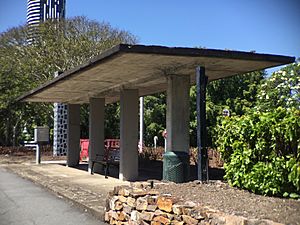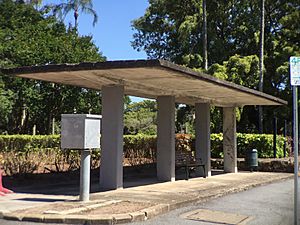Albert Park (South) Air Raid Shelter facts for kids
Quick facts for kids Albert Park (South) air raid shelter |
|
|---|---|

Albert Park (South) Air Raid Shelter, 2015
|
|
| Location | Albert Park, Upper Albert Street, Brisbane City, City of Brisbane, Queensland, Australia |
| Design period | 1939 - 1945 (World War II) |
| Built | c. 1942 |
| Architect | Frank Gibson Costello |
| Official name: Albert Park (South) Air Raid Shelter | |
| Type | state heritage (built) |
| Designated | 31 May 2005 |
| Reference no. | 602474 |
| Significant period | 1942 (fabric) 1940s (historical) |
| Builders | Brisbane City Council |
| Lua error in Module:Location_map at line 420: attempt to index field 'wikibase' (a nil value). | |
The Albert Park (South) air raid shelter is a special building in Albert Park, Brisbane City, Queensland, Australia. It was built around 1942 during World War II to protect people from air raids. It was designed by Frank Gibson Costello and built by the Brisbane City Council. Today, it is recognized as an important historical site on the Queensland Heritage Register.
A Shelter from the Sky
The Brisbane City Council built this concrete shelter in Albert Park in 1942. It was a time when people in Australia were worried about attacks from the sky.
World War II Comes to Australia
On December 7, 1941, the United States of America joined World War II. This happened after Japan attacked the American fleet at Pearl Harbor in Hawaii. England and its Commonwealth countries, like Australia, had been at war with Germany since 1939. Now, the war was truly global.
Japanese forces bombed Darwin on February 19, 1942. About 14,000 Australians were captured after the fall of Singapore. Plans were quickly made to defend Australia from a possible Japanese invasion. Queensland became an important support base for the war in the Pacific. Many Australian and American soldiers came to Queensland. They needed new buildings and facilities quickly.
Brisbane Prepares for War
The number of people in Brisbane grew very fast. Brisbane was the largest city in Queensland and the most northern big city in Australia. Because of this, military headquarters were set up here. Important places for maintenance, communication, and supplies were also built.
General Douglas MacArthur, who led the Allied Forces in the Southwest Pacific, was based in Brisbane. General Sir Thomas Blamey, who led the Australian Forces, also used buildings in Brisbane. Brisbane was clearly a target for bombing. So, quick action was needed to protect people if air raids happened.
Building materials, services, and workers were in high demand. Military projects were given first priority. Large anti-aircraft guns were set up in places like Victoria Park and Fort Lytton. Coastal guns were placed on Bribie and Moreton Islands. Before the war, Queensland did not have many people or big factories. To help, some buildings were made in parts and then put together. Standard designs were used for many structures. These designs also considered that skilled workers and some materials were hard to find.
Building Public Shelters
The Brisbane City Council was in charge of Air Raid Precautions (ARP). This included setting up air raid wardens and firefighting systems. They also built air raid shelters. Large saltwater pipes were laid along city streets to help fight fires.
By late 1941, each Australian State was told to start building shelters right away. Trenches were dug in parks and schoolyards. Windows were taped, and buildings had "brownouts" (dimmed lights) to make them less visible from the air.
On December 23, 1941, the Premier of Queensland, William Forgan Smith, ordered the Brisbane City Council to build 200 public shelters in the city. Work had already begun on December 15. Later, 75 more shelters were ordered. However, only 235 air raid shelters were built in total. Most were finished by June 1942.
In addition, about three kilometers of covered trenches were built in public parks. This included 315 meters of concrete-pipe trenches in the City Botanic Gardens. It was thought that one person could fit in each foot of trench. The Brisbane City Council also built shelters for wharves and council buildings. Shelters were even built under the Story Bridge for workers.
Shelters Across Queensland
The order to build shelters applied to all of Queensland. Outside Brisbane, 24 other local councils in coastal areas were told to build shelters for the public. These shelters had to follow a special Air Raid Shelter Code.
Initially, 20 local councils were expected to build at least 133 shelters. These shelters were supposed to be strong enough to survive a 500-pound bomb exploding 50 feet away. Four other councils would only build trenches. In the end, 23 local councils outside Brisbane built 129 public shelters. Most of these were above ground.
Clever Designs for the Future
Of the 235 shelters built in Brisbane, 21 still exist today and are owned by the Brisbane City Council. Most of these surviving shelters were designed to be reused after the war.
Frank Gibson Costello was the Brisbane City Council's City Architect from 1941 to 1952. He was responsible for designing these shelters. He wanted them to have a purpose after the war. In February 1942, Costello said that if the shelters were not needed for air raids, they would just be empty concrete buildings. He tried to design them so they could be used for other things later.
Costello's designs were modern. He used new materials and focused on how buildings would be used. His designs often featured straight lines, flat roofs, and a strong, simple look. The reusable shelters were often placed under fig trees to help hide them.
One of Costello's reusable designs was the "park" type shelter. These shelters had four central pillars supporting the roof. This allowed the four outer walls to be removed after the war. This would turn them into open park shelters. There were entrances at each end of the front wall.
Of the 37 "park" type shelters built, 17 still survive today. Two of these are in Albert Park (one north, one south). Most are now used as simple park shelters, just as Costello planned. Some had concrete walls, while others used brick.
Another design was the "bus" type shelter. These were designed so that three brick walls could be removed. This would leave a concrete back wall and five brick pillars at the front. Only two of these "bus" type shelters still exist.
A third design was also a "bus" type, but it had a stone back wall and six stone pillars. Only one of these "colonnade" type shelters survives.
Most of the buildings made for the war in Brisbane were removed after World War II. The saltwater pipes, trenches, and sirens disappeared. Many standard shelters that stood in the middle of streets were also removed. None of the 156 standard shelters built in the city center still exist. However, 20 of Costello's 58 reusable shelters have survived. Removing their walls, as planned, gave them a new purpose.
The outer walls of the Albert Park (South) air raid shelter were removed after World War II. You can still see where the walls used to be. Seats have been added, and a colorful rainbow serpent mosaic now decorates one of the pillars.
What the Shelter Looks Like
The Albert Park (South) air raid shelter is a rectangular concrete building. It has a strong floor and a flat roof supported by concrete pillars. The shelter stands on the footpath at the southern corner of Albert Park. It has flowerbeds on either side. Inside, there is a wooden seat with concrete legs.
The shelter is unpainted. A beautiful rainbow serpent mosaic design is on the south side of the northern pillar. A rubbish bin stand is bolted to the floor. You can still see marks on the floor where the two entrances used to be.
Why It's Important (Heritage Listing)
The Albert Park (South) Air Raid Shelter was added to the Queensland Heritage Register on May 31, 2005. This means it is recognized as a very important historical place.
Showing History
This air raid shelter is important because it shows how Queensland's history changed during World War II. It was built to protect people in Brisbane from air raids. It helps us understand how the war affected everyday people in the city.
A Rare Survivor
Many air raid shelters were built in Queensland during World War II, but only a few are still standing. This shelter is one of the few types of wartime buildings made by the Brisbane City Council that still exist.
A Typical Example
The shelter's strong build, rectangular shape, and location near many people show what a typical World War II public air raid shelter in Brisbane was like.
Creative Design
The Albert Park (South) air raid shelter is now used as a shade shelter. This shows how clever its original design was, allowing it to be used for a different purpose after the war. It is a lasting example of smart design and the use of concrete during World War II.
Special Connection
This air raid shelter is important because it shows the work of the City Architect's Office during the war, especially the designs of City Architect F.G. Costello.


